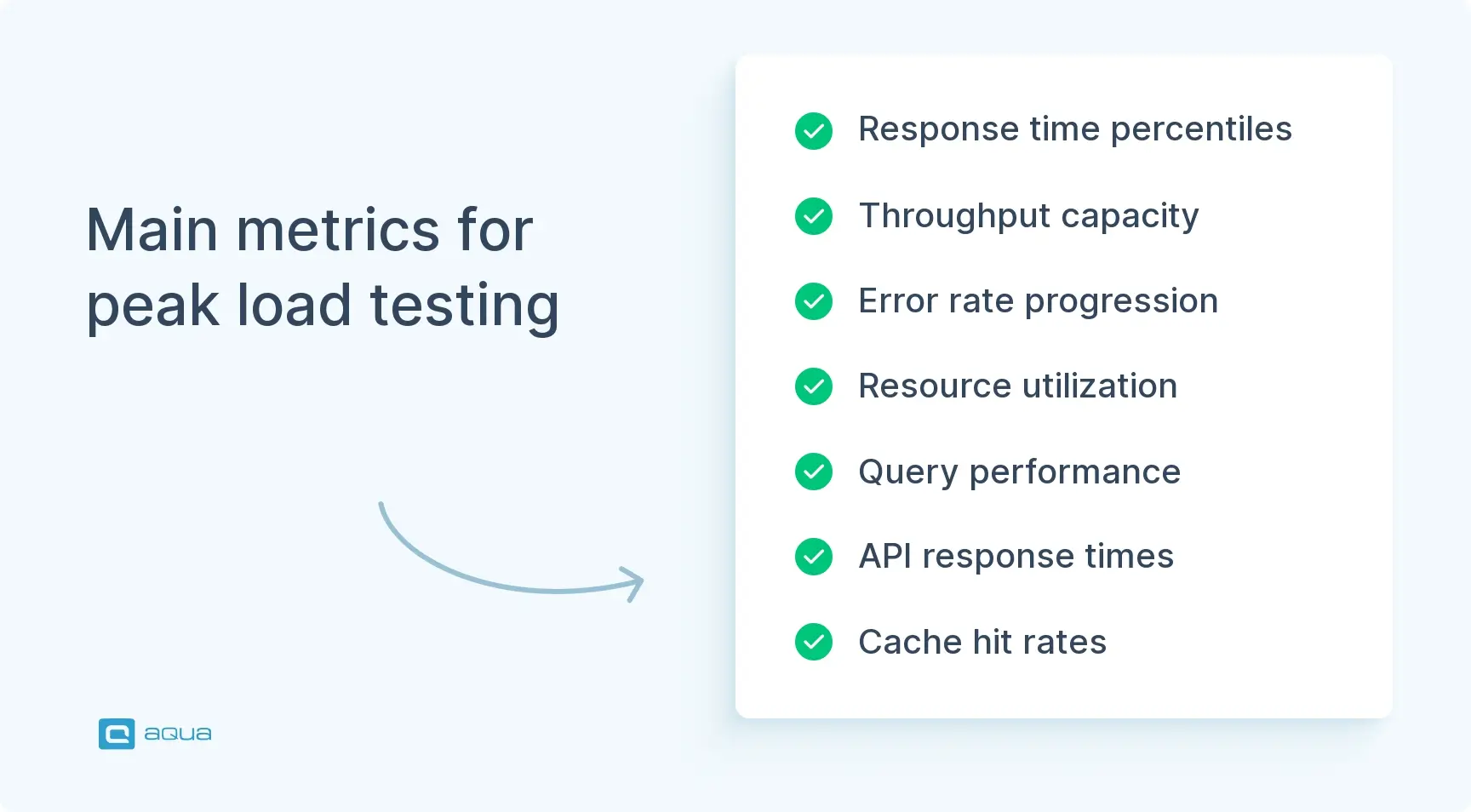Key takeaways
- Peak load testing simulates 150 to 200% of anticipated peak traffic to identify breaking points before real customers arrive.
- Black Friday generates 20 to 30 times normal traffic, with 53% of mobile users abandoning sites that take longer than 3 seconds to load.
- Critical metrics include response time percentiles, throughput capacity, error rate progression, and resource utilization patterns across your stack.
- Start load testing 6 to 8 weeks before Black Friday to allow multiple iterations, infrastructure optimization, and final validation.
- Database performance under concurrent load often becomes the limiting factor, exposing connection pool exhaustion and query performance issues invisible during normal operation.
Major retailers lose $10,000 per minute during site outages. A three-hour Black Friday crash costs nearly $2 million in lost sales. Learn how peak load testing prevents catastrophic failures during your busiest season 👇
Why Black Friday Puts Extreme Pressure on Systems
Black Friday traffic doesn’t ramp up gradually. It spikes instantly when deals go live. Thousands of users hit product pages at the exact same moment. They can do various things on the website, including:
- Add items to carts
- Check out
- Abandon purchases and start over.
Each action triggers database queries, API calls, payment processing, and inventory updates.
Normal load patterns don’t prepare you for this reality. Your system might handle steady traffic beautifully. Then Black Friday hits, and suddenly, 50,000 people slam your checkout page at once. Database connections max out in seconds. Memory fills up. Response times that were barely noticeable balloon from milliseconds to agonizing 10-second waits.
Customers stare at loading spinners. They get timeout errors or see nothing but blank pages. They don’t wait around. They bail and head straight to your competitor, whose site loads instantly.
The pressure compounds across your entire stack in ways you don’t see coming:
- Web servers field the initial flood of requests
- Application servers scramble to process business logic for thousands of simultaneous transactions
- Databases choke trying to execute queries under a massive concurrent load
- Third-party services (payment gateways, shipping calculators, inventory systems) get pummeled simultaneously
One bottleneck anywhere in this chain kills performance everywhere. Your payment gateway slowing down by two seconds means every checkout takes two seconds longer, regardless of how fast your servers run.
Peak season also brings uninvited guests. Bots crawl your site, scraping pricing data. Competitors run scripts monitoring your inventory levels. Actual DDoS attacks blend into the chaos of legitimate traffic, making them nearly impossible to distinguish. Your systems need to separate real customers from malicious requests, too. All the while, somehow, you need to maintain acceptable performance for both legitimate users and the onslaught of garbage traffic.
The financial stakes get ugly fast:
- 53% of mobile users abandon sites that take longer than 3 seconds to load
- During Black Friday, that percentage climbs higher as shoppers have a dozen competitor tabs open
- Major retailers can lose $10,000 per minute during an outage
- A three-hour crash during peak shopping translates to nearly $2 million in evaporated sales
- Long-term damage to customer trust and brand reputation compounds the immediate losses
Your site lags; they click the next tab. Every second of downtime translates directly to lost revenue.
What is Load Testing?
Load testing simulates real user traffic to see how your system performs under expected and extreme conditions. You create virtual users that browse pages, search products, add items to carts, and complete checkouts, just like actual customers do. The goal is finding performance bottlenecks, capacity limits, and failure points before real traffic hits.
What is peak load testing?
Peak load testing focuses specifically on maximum concurrent user scenarios. You simulate the highest traffic your system will face, typically 150 to 200% of the anticipated peak, to build in a safety margin.
What is peak load in performance testing? It’s the maximum number of simultaneous users or transactions your system can handle while maintaining acceptable performance. Finding this threshold tells you exactly when things break and why.
How load testing works
- Virtual users execute predefined scripts (navigate to homepage, search for “wireless headphones,” click product, add to cart, proceed to checkout)
- You scale this to thousands of concurrent sessions
- Tools measure how your system responds as the load increases
- Data reveals your exact breaking point
Response times might stay under 2 seconds with 5,000 users, but jump to 15 seconds at 7,500 users. That gap between expected load and breaking point is your safety margin.
What peak load performance testing reveals
- Database connection pools that seem adequate suddenly bottleneck
- Memory leaks that take days to matter become critical in hours
- Third-party API rate limits you never hit, suddenly block requests
- Caching strategies that work fine normally prove inadequate under spike conditions
Metrics measured during load testing
Testing happens in controlled environments where you track everything:
- CPU usage across all servers
- Memory consumption patterns
- Database query execution times
- Network latency
- API response times
- Cache hit rates

You collect this data under various load levels. This way, you are creating a performance profile showing exactly how your system degrades as traffic increases.
Managing load testing alongside your broader QA workflow requires coordination across teams. aqua cloud integrates performance testing with functional testing, requirements management, and defect tracking in one platform. Your load test results connect directly to requirements, showing which performance criteria are met or failing. Defects discovered during load testing get tracked with full context. Test planning covers both functional and performance scenarios in unified workflows. This integration means your QA team doesn’t juggle separate tools for different testing types. Everything lives in one place with complete traceability from requirements through test execution to defect resolution.
Prepare for peak season with integrated QA management
Why Load Testing Is Critical Before Black Friday and Other Peak Seasons During the Year
Load testing before peak season delivers impeccable benefits that protect both revenue and reputation. Here’s what it actually accomplishes:
Revenue protection through uptime
Every minute of downtime during peak season costs direct revenue. Load testing identifies and fixes issues before they cause outages. You’re protecting customer lifetime value, too. Shoppers who experience checkout failures during Black Friday don’t just abandon that purchase. They also remember. They go elsewhere permanently.
Customer experience under pressure
Slow sites during peak season create lasting negative impressions. Load testing ensures your site remains responsive when it matters most. You validate that page load times stay under acceptable thresholds, checkout flows complete without errors, and the entire experience feels smooth even when traffic spikes.
Infrastructure cost optimization
Load testing shows exactly how much infrastructure you actually need. Many businesses over-provision servers “just to be safe,” wasting money on unused capacity. Others under provision and crash. Testing reveals the right balance. You scale efficiently, spending on resources that deliver ROI instead of guessing.
Third-party service validation
Your site depends on payment processors, shipping calculators, inventory systems, CDN providers, and analytics platforms. Load testing validates that these integrations hold up under peak conditions. You discover rate limits, timeout configurations, and failure modes before customers do. If a payment gateway can only process 100 transactions per second, you need to know that before 500 customers try to check out simultaneously.
Database performance under concurrent load
Databases fail differently under peak load than under normal conditions. Lock contention explodes. Query execution plans that work with small datasets fall apart with concurrent access. Connection pools exhaust. Load testing exposes these database-specific issues while there’s time to optimize indexes, adjust connection settings, or implement caching layers.
Regulatory and compliance requirements
Many industries require documented performance testing before major events. Financial services, healthcare, and government contractors often need proof that their systems can handle peak load. Load testing provides that documentation. You demonstrate due diligence, satisfy audit requirements, and avoid compliance penalties.
Core Metrics to Evaluate During Load Testing
Successful load testing depends on tracking the right metrics. These measurements tell you exactly where your system stands and what needs fixing:
Response time under load
Measure how long requests take to complete as concurrent users increase. Track percentiles, not just averages. The 95th percentile response time tells you what slower users experience. If the average response time is 1.5 seconds but the 95th percentile is 8 seconds, 5% of your customers are suffering. During Black Friday, 5% of traffic represents thousands of frustrated shoppers.
Throughput capacity
Measure the transactions per second your system can process. This shows your ceiling. If you can handle 500 checkouts per minute but expect 800 during peak, you’ve got a problem. Throughput metrics reveal exactly where capacity limits hit and which components become bottlenecks first.
Error rate progression
Track error rates as load increases. Systems don’t fail in a binary fashion. They degrade gradually. Error rates might stay at 0.1% with 2,000 users, jump to 2% at 5,000 users, and hit 15% at 7,000 users. Mapping this progression shows your safe operating range and the point where things start breaking.
Resource utilization patterns
Monitor CPU, memory, disk I/O, and network usage across all servers during tests. Resource exhaustion causes most performance failures. If the CPU hits 90% at 60% of the expected peak load, you need more capacity or optimization. Memory leaks show up as steadily increasing RAM usage over time. Disk I/O bottlenecks reveal inadequate storage performance.
Database query performance
Measure query execution times under concurrent load. Queries running in 50ms normally might take 5 seconds when 1,000 users hit the database simultaneously. Identify slow queries, missing indexes, and lock contention issues. Database performance often becomes the limiting factor during peak load.
Third-party API response times
Track how external services respond under load. Payment gateway latency, shipping calculator response times, and inventory system queries all impact user experience. If a critical API takes 3 seconds to respond, your checkout can’t complete faster than that, regardless of how well your infrastructure performs.
Cache effectiveness rates
Monitor cache hit rates under peak load. Caching strategies that work during normal traffic might prove inadequate when requests spike. Low cache hit rates force expensive database queries or API calls, multiplying load on backend systems. High hit rates indicate effective caching that will protect your infrastructure during actual peak season.
Connection pool exhaustion timing
Measure when database connection pools, API connections, or other pooled resources are exhausted. If your connection pool empties at 70% of the expected peak load, requests start queuing, and response times explode. This metric tells you exactly how much headroom you have and when you’ll hit limits.
Black Friday Readiness Checklist: Your Load Testing Plan
A systematic approach to load testing ensures you cover everything that matters. Follow this checklist to validate peak season readiness:
Define realistic peak traffic scenarios
Calculate expected concurrent users based on historical data, marketing spend, and competitive intelligence. Add 50 to 100% buffer for unexpected viral traffic or competitive failures driving customers to you. Break scenarios into specific user journeys: browse only, add to cart and abandon, complete checkout. Weight these based on actual behavior patterns from past peak seasons.
Set up comprehensive monitoring before testing
Instrument every layer of your stack before running load tests. Application performance monitoring, server metrics, database query profiling, network traffic analysis, third party API monitoring. You can’t fix what you can’t measure. Monitoring captures the data showing exactly where and why performance degrades under load.
Create production-like test environments
Test in environments matching your production infrastructure. Scaled-down environments produce misleading results. If production runs 10 web servers but you test with 2, you will have problems. You won’t be able to catch load balancer issues, network bottlenecks, or database connection problems that only surface at scale. Mirror your production setup as closely as budget allows.
Script realistic user behavior patterns
Build load test scripts that mimic actual customer behavior, not just HTTP requests. Real users browse multiple pages, spend time reading product details, add and remove cart items, apply discount codes. Unrealistic test scripts produce unrealistic results. Study your analytics to understand actual user flows, then replicate them in test scenarios.
Run incremental load tests before peak simulation
Don’t jump straight to maximum load. Run incremental tests ramping from baseline to peak over 30 to 60 minutes. This reveals how performance degrades gradually and identifies the specific threshold where problems start. You might handle 3,000 users perfectly, but start failing at 3,500 users. That data pinpoints exactly what needs optimization.
Execute sustained load testing for endurance validation
Peak season lasts hours, not minutes. Run endurance software testing at peak load for extended periods (2 to 4 hours minimum). This exposes memory leaks, connection pool leaks, and gradual resource exhaustion that won’t show up in short burst tests. Systems that pass 30-minute load tests sometimes fail after 3 hours as resources slowly deplete.
Test disaster recovery and failover procedures
Simulate component failures during peak load. What happens if a database server crashes? Does your load balancer correctly route around failed web servers? Do your auto scaling policies trigger appropriately? Testing these scenarios under load validates that your redundancy actually works when needed, not just in theory.
Validate auto scaling configurations
If you’re using cloud infrastructure with auto scaling, validate it triggers appropriately during load tests. Many auto scaling policies are misconfigured, scaling too slowly or not at all. Run load tests that exceed your baseline capacity and verify new instances spin up before performance degrades. Check scale down policies too. Aggressive scale down during temporary traffic dips can leave you under provisioned when the next wave hits.
Review and optimize based on test results
Analyze every metric collected during load testing. Identify bottlenecks, optimize code, tune database queries, adjust infrastructure configurations, and implement caching strategies. Then retest to validate improvements actually worked. This cycle continues until you consistently pass peak load scenarios with acceptable performance across all metrics.
Document findings and create runbooks
Capture everything learned during load testing in runbooks. Document the exact load levels where problems emerged, what fixed them, and operational procedures for monitoring and responding during actual peak season. These runbooks guide your team during Black Friday when issues surface and decisions need to happen fast.
Schedule final validation test close to peak season
Run one final comprehensive load test 1 to 2 weeks before Black Friday. This validates that all optimizations still work after recent code deployments, infrastructure changes, or configuration updates. It’s your last chance to catch regressions before real customers arrive.
Best Tools for Effective Load Testing
aqua cloud
Comprehensive QA platform integrating load testing with broader software testing workflows. Manages test planning, execution, and reporting in unified environment. Your load test results connect directly to requirements, showing which performance criteria pass or fail. Defects discovered during load testing get tracked with full context linking back to specific test scenarios and requirements. Collaboration features help teams coordinate complex testing efforts across multiple stakeholders. The platform handles functional testing, performance testing, and defect management together, eliminating tool sprawl. Good fit for organizations wanting integrated testing platform covering all QA needs without juggling separate tools for different testing types.
aqua cloud
Comprehensive QA platform integrating load testing with broader software testing workflows. Manages test planning, execution, and reporting in unified environment. Your load test results connect directly to requirements, showing which performance criteria pass or fail. Defects discovered during load testing get tracked with full context linking back to specific test scenarios and requirements. Collaboration features help teams coordinate complex testing efforts across multiple stakeholders. The platform handles functional testing, performance testing, and defect management together, eliminating tool sprawl. Good fit for organizations wanting integrated testing platform covering all QA needs without juggling separate tools for different testing types.
Transform your peak season testing workflow with 100% AI-powered solution
Apache JMeter
Open source load testing tool handling HTTP, HTTPS, FTP, JDBC, and more. JMeter excels at complex test scenarios with extensive customization. Free but requires technical expertise to configure properly. Strong community support and extensive plugin ecosystem. Works well for teams with development resources who need fine-grained control over test scenarios.
Gatling
Code based load testing tool using Scala for test scripts. Generates highly efficient load with minimal infrastructure. Gatling produces detailed HTML reports showing performance metrics across test duration. Ideal for teams comfortable with code who want precise control and efficient resource usage. Open source core with commercial enterprise features.
k6
Modern open source load testing tool using JavaScript for test scripts. Developer friendly API makes creating realistic load tests straightforward. Strong CI/CD integration for automated performance testing. Cloud execution option for large scale tests. Growing community and active development. Good fit for teams adopting infrastructure as code practices.
LoadRunner
Enterprise load testing platform from Micro Focus. Comprehensive protocol support, detailed analytics, and extensive scripting capabilities. High licensing costs but extensive features for complex enterprise environments. Strong correlation and parameterization tools for realistic test data. Best for large organizations with a budget for commercial tools and complex testing requirements.
BlazeMeter
Cloud-based load testing platform compatible with JMeter scripts. Eliminates infrastructure management for large-scale tests. Runs tests from multiple geographic locations simultaneously. Built-in reporting and analysis dashboards. Paid service with usage-based pricing. Works well for teams needing scale without managing test infrastructure.
Locust
Python based open source load testing tool. Define user behavior in Python code, making test creation accessible to developers. Distributed load generation across multiple machines. Real time web UI shows test metrics during execution. Lightweight and efficient. Great for Python shops and teams wanting code based test definition.
Artillery
Modern open source load testing toolkit built on Node.js. YAML based test definitions make creating tests straightforward without extensive coding. Strong WebSocket and Socket.io support for real time application testing. Built in support for AWS Lambda for serverless load generation. Ideal for teams testing modern web applications and APIs.
Choosing tools depends on your team’s technical capabilities, budget, scale requirements, and existing toolchain. Many teams use multiple tools: open source solutions like JMeter or k6 for regular testing, cloud platforms like BlazeMeter for large scale peak season validation. The best tools for load testing match your specific needs, not feature checklists.
Conclusion
Load testing before Black Friday will separate successful peak seasons from massive failures. Peak load performance testing reveals exactly where your systems break and why. It gives you time to fix issues before real customers arrive. The checklist we outlined provides a systematic approach: define realistic scenarios, instrument comprehensively, test incrementally, validate endurance, and optimize based on data. Start testing at least 6 to 8 weeks before peak season. That timeline allows multiple test iterations, fixes, and validation. Waiting until two weeks before Black Friday leaves no margin for discovering serious infrastructure issues. Your competitors are testing. Your customers expect sites that work. Load testing ensures you deliver.

















